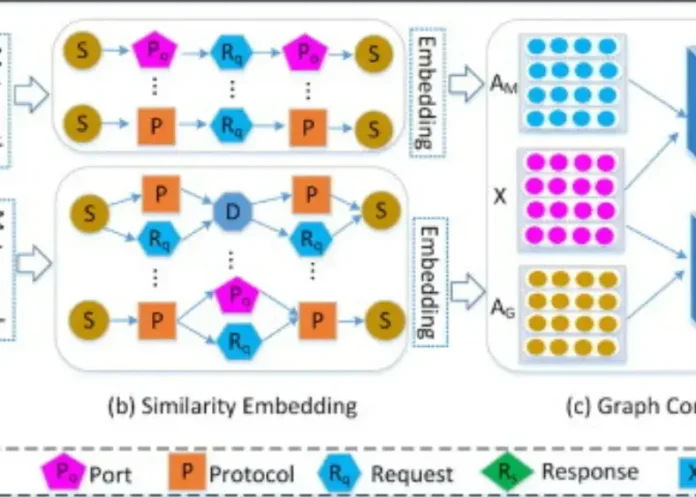Preliminary Information
Real-world networks are very complex; there are multiple types of nodes and edges. Its complexity renders these networks multiplex and heterogeneous, making them a challenge to traditional graph-based learning techniques. GRAF stands to answer such challenges for such networks, algorithming them for their aptness toward graph representation learning.
Obstacles from the Current Approaches
Most of the current techniques that deal with heterogeneous networks-from meta-path transformation to GNN-based-reality almost all seem to falter at the crucial point of scalability and effective interpretation of node and edge importance. MOGONET and SUPREME have tried to use separate layers for predictions, whereas attention-based architectures, like HAN and HGT, suffer either from extreme computational redundancy or inefficiency. This all puts very strong pressure on the requirement for a federation solution that properly bridges these gaps.
| Existing Techniques | Advantages | Limitations |
|---|---|---|
| Meta-path transformations | Simplifies network analysis | May not scale effectively |
| GNN-based solutions | Separate layer processing | High redundancy and computational costs |
| Attention-driven architectures | Focus on significant nodes | Inefficient handling of edge importance |
The GRAF Framework
Such issues are overcome with the establishment of GRAF framework which has been meant for multiplex heterogeneous networks mapping into a unified, interpretable representation by employing the advanced mechanisms like:
Node-Level: Attention judgment on the importance pertaining to the importance of neighboring nodes.
Layer-Level: Importance evaluated as per the network layers.
This sums up all the networks into a single weighted graph while filtering out the minor importance edges and thus simplifies the network while ensuring the critical elements are preserved.
Methodology of GRAF
It is comprised of several steps that are properly structured to process multiplex heterogeneous networks efficiently.
- Meta-Path Transformations: For example, represent heterogeneous networks as multiplex networks (such as movie-director-movie for IMDB).
- Node-Level Attention Calculation: Determining critical neighbors.
- Layer-Level Attention Calculation: It assesses the importance of the different layers of the network.
- Consolidation of Attention Weights: It focuses critical relations by evaluate key relationship consequences in an edge scoring function.
After constructing the coupled graph, GRAF leverages a 2-layer Graph Convolutional Network (GCN) to incorporate graph topology and node features, effectively completing tasks such as node classification.
| GRAF Methodology Steps | Description |
|---|---|
| Step 1: Meta-Path Transformations | Transforms networks into multiplex representations |
| Step 2: Node-Level Attention | Chooses significant neighbors |
| Step 3: Layer-Level Attention | Assesses importance of network layers |
| Step 4: Edge-Scoring Function | Prioritizes important relationships |
Performance Evaluation Results
GRAF’s efficiency was validated through experiments using distinct datasets such as IMDB, ACM, DBLP, and DrugADR where they inculcated particular meta-path transformations depending upon the characteristics of individual datasets.
Results Attained:
- Macro F1 score for predicting movie genre: 62.1%
- Macro F1 Score Ensuing Adverse Drug Reaction Prediction: 34.7%
- Paper type classification: 92.6%
- Classifying an Author’s Research Area: 91.7%
GRAF has shown better performance compared to all these benchmarks but also verified the importance of its attention mechanisms through ablation studies, reinforcing its modular design.
| Datasets | Tasks | GRAF Performance |
|---|---|---|
| IMDB | Movie Genre Prediction | 62.1% macro F1 score |
| DrugADR | Adverse Drug Reaction Prediction | 34.7% macro F1 score |
| ACM | Paper Type Classification | 92.6% |
| DBLP | Author Research Area Classification | 91.7% |
When it comes to the analysis of multiplex heterogeneous networks, the GRAF framework stands out as-a-novel approach. Indeed, its interpretability-centered integration of different network layers makes graph representation learning far better because it makes the efficient and scalable machinery of GRAF available for use-as a paradigm shift for significant advancements in biomedicine, social networks, or multi-modal data interpretation.
In terms of redefining the future perspectives of graph neural networks, it opens the stage to allow scope for many more developments in the representation methodologies for networks. Continuous exploration of these developments will prove vital in looking ahead into the future advancements in the field.

